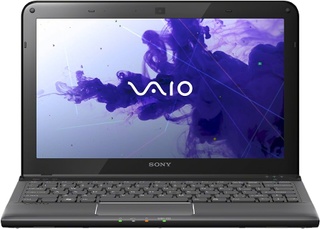Acer Aspire E3-111 11.6" Intel Celeron N2830 vs Sony Vaio E11 11.6" AMD E2-1800
Welcome to our detailed analysis of two popular compact laptops: the Acer Aspire E3-111 and the Sony Vaio E11. Each presents a unique combination of features, strengths, and potential limitations. Focusing on user experience, we'll examine their design attributes, durability, and performance competencies. Whether you're a student in need of a dependable device for academic tasks, or a professional looking for portability without sacrificing power, this guide is here to assist you in making an educated decision between these two models. Let's delve into the comparison of these laptops!
System and application performance
Performance in popular 3D games
Viewing angle, color accuracy...
Ports, webcam and other interfaces
Potential battery life
Materials, durability and portability
Design Comparison
Size Comparison
The Acer Aspire E3-111 and Sony Vaio E11 are compact laptops, each catering to unique user requirements:
Acer Aspire E3-111: Lightweight and User-friendly
The Acer Aspire E3-111 stands out as a perfect companion for those always on the move. With its feather-light weight of just 1.29 kg, it barely tips the scale, offering unrivalled portability. Whether you're a student zipping from one lecture to another, or a busy professional constantly travelling, this is your go-to laptop.
This model's design is notably uncomplicated and straightforward. The chic, understated aesthetic is complemented by a stylish metallic finish that grants it sophistication. With a roomy and cosy keyboard, long typing sessions have never been more comfortable.
One of the handy features of the Acer Aspire E3-111 is its variety of ports. From HDMI to USB 3.0, this laptop offers a range of connectivity choices, making it easy for users to effortlessly connect other gadgets such as flash drives or external screens.
Sony Vaio E11: Robust Build with Extra Features
The Sony Vaio E11 brings some extra flair with its design. Weighing slightly more than the Acer at 1.5 kg, it compensates with a robust build quality that promises durability—a key consideration for users who travel frequently or use their laptops in rugged environments.
This model distinguishes itself with its illuminated keyboard - a characteristic that boosts visual appeal and usability. Users can type with ease in dimly lit conditions without eye strain, which is an advantage for anyone working late into the night or students studying round the clock.
The Sony Vaio E11 also offers ample connectivity options similar to the Acer model but goes a step further by including a VGA connector—an old-school touch that could be beneficial for users needing to connect older display devices.
Verdict: Choose Based on Lifestyle and Usage
In essence, each laptop appeals to unique preferences and requirements. The Acer Aspire E3-111, with its light construction and user-friendly design, is an excellent option for those who appreciate easy mobility and uncomplicated use—perfect for students or busy professionals.
Alternatively, the Sony Vaio E11, with its solid construction and additional features such as a backlit keyboard, provides improved comfort and longevity. It's an excellent choice for individuals who often operate in different light settings or need a resilient laptop capable of enduring regular travel or heavy duty use..
Screen Comparison
| Acer Aspire E3-111 11.6" Intel Celeron N2830 | Sony Vaio E11 11.6" AMD E2-1800 | |
|---|---|---|
| Resolution | HD | HD |
| Screen Size | 11.6" | 11.6" |
Comparing the Acer Aspire E3-111 and Sony Vaio E11, each boasts unique screen display features that could elevate your user experience. Whether you're gaming, streaming, or designing, these laptops cater to your needs differently. Let's demystify their specifications:
Screen Size and Resolution
Both laptops feature a travel-friendly 11.6-inch screen size. Ideal for those constantly on the move, or those who value compactness for easy portability.
Both laptops offer a resolution of 1366 x 768 pixels, providing satisfactory sharpness for everyday use. However, if you're an avid gamer or a professional designer seeking exceptional detail in graphics, these may not be your top picks due to their standard resolution.
Pixel Density
Screen resolution is a key detail to keep in mind during laptop comparisons. Both laptops feature the same pixel density, standing at 135 ppi (pixels per inch). This suggests that both devices offer reasonably clear displays, making them ideal for typical internet use, casual gaming, and work tasks.
If you're into graphic design or photo editing, every color detail matters. In such cases, opt for laptops with greater pixel density - they'll deliver the crisp precision you need.
Display Technology
Take a look at the Acer Aspire E3-111 and Sony Vaio E11 - both come equipped with LED-backlit LCD screens. This tech lingo simply means you're in for a treat with bright, colorful visuals that make your movies or videos pop. However, don't expect to view from wide angles like you would with some premium models - neither of these laptops offer In-Plane Switching (IPS). So, while they're perfect for head-on viewing, they might not be the top choice for gathering a group around your screen.
Gaming enthusiasts, take note. From certain angles, colors could appear less vibrant, potentially affecting the visual quality of your gaming experience. Similarly, for creative professionals who depend on consistent color display from all angles, like graphic designers, this aspect might pose a challenge.
In conclusion, these two laptops share similar screen features, making them perfect for everyday activities such as surfing the internet, video streaming, or managing standard office work. But, if you're a gaming aficionado or a professional designer requiring advanced display capabilities and superior resolution for intricate graphics, these laptops may not meet your specific needs.
Hardware Comparison
| Acer Aspire E3-111 11.6" Intel Celeron N2830 | Sony Vaio E11 11.6" AMD E2-1800 | |
|---|---|---|
| RAM | 2GB | 4GB |
| Storage Size | 320GB | 500GB |
In the realm of budget-friendly laptops, the Acer Aspire E3-111 and Sony Vaio E11 stand out as strong contenders. Their compact design belies their powerful capabilities. However, certain distinctions between them could guide your decision towards one over the other. So, let's delve deeper into their hardware aspects.
Processing Power
The Acer Aspire E3-111 comes packed with an Intel Celeron N2830 processor that runs at a speed of 2.16GHz. This entry-level, dual-core processor is tailored to save energy, making it a great fit for your everyday tasks such as surfing the web or editing documents.
In comparison, the Sony Vaio E11 is powered by an AMD E2-1800 processor, clocking at 1.7GHz. Just like the Acer model, it has dual cores but functions at a marginally slower pace. However, its performance remains sufficient for your daily computer activities.
Memory and Storage
The Acer Aspire arrives equipped with a 2GB RAM, perfectly suited for light multitasking. But here's the best part - you have the flexibility to boost it up to 8GB if you ever need that extra muscle in the future.
Unlike its counterparts, the Sony Vaio comes packed with twice the RAM - a full 4GB. This means you'll experience seamless multitasking right from the start. Whether you're running several apps at once or using software that demands more memory, this laptop is designed to keep up and enhance your performance.
With storage being a crucial factor, it's interesting to note that the Acer laptop comes equipped with a 320GB hard drive. On the other hand, the Sony model edges ahead, offering a more spacious 500GB hard drive. What does this mean for you? Simply put, more storage equals greater space for all your essentials - be it files, photos, videos or applications.
Graphics Performance
Both laptops come with integrated graphics units meaning they share memory with CPU and are not suitable for heavy gaming or professional graphic design tasks. However, they suffice for casual gaming or watching movies.
Final Thoughts
In conclusion, both laptops serve as good options for everyday computing tasks. The Acer Aspire E3-111 might be a better pick if you're after energy efficiency and plan on doing light multitasking, while the Sony Vaio E11 offers more immediate multitasking power and larger storage space which could be beneficial if you tend to run multiple applications or store lots of media files.
Battery Comparison
| Acer Aspire E3-111 11.6" Intel Celeron N2830 | Sony Vaio E11 11.6" AMD E2-1800 | |
|---|---|---|
| Battery Life | 5 hours | 4 hours |
Battery life plays a crucial role in laptop performance. It's essential to have a laptop that keeps pace with your busy schedule. Now, let's uncover the battery details of two renowned 11.6" models: The Acer Aspire E3-111 and the Sony Vaio E11. These machines not only offer impressive processing power and storage but also promise to be your reliable companions on-the-move.
Acer Aspire E3-111: The Long-Distance Runner
The Acer Aspire E3-111 presents a reliable battery life, lasting up to 5 hours when fully charged. This gives you ample opportunity to work or enjoy leisure activities without the need for constant access to a power source. Central to this performance is a 2640 mAh battery, which performs well for a laptop of this scale. An additional feature of interest is the incorporation of Sleep and Charge USB ports. These enable charging of your devices through your laptop, even while it's in sleep mode - a convenient attribute during extended journeys.
Sony Vaio E11: The Reliable Companion
On the other hand, we have the Sony Vaio E11. It sports a slightly shorter battery life at around 4 hours per charge. While not quite as long-lasting as the Acer model, this should still be sufficient for most typical use scenarios like browsing, writing documents or watching videos. Like its competitor, the Sony Vaio also comes equipped with Sleep and Charge USB ports - a thoughtful inclusion that adds practicality.
Conclusion: Make Your Pick
To sum it up, if maximum unplugged time is high on your priority list, then the Acer Aspire E3-111 with its longer battery life might be your perfect partner. However, if you value reliability and are okay with a slightly shorter battery duration, then don't rule out the Sony Vaio E11. Both these models offer the added convenience of Sleep and Charge USB ports, so there's no clear winner in that department. In the end, it all boils down to your specific needs and usage patterns.
Verdict
Why Acer Aspire E3-111 11.6" Intel Celeron N2830?
- Acer Aspire E3-111 is lighter and more portable, ideal for users always on the move.
- Acer Aspire E3-111 offers a variety of ports including HDMI and USB 3.0 for enhanced connectivity options.
- Acer Aspire E3-111 has a sleek design with a comfortable keyboard layout, making it user-friendly for long typing sessions.
Why ?
- Sony Vaio E11 offers a robust build quality and durability, making it ideal for frequent travelers or users in rugged environments.
- Sony Vaio E11 features an illuminated keyboard for enhanced visual appeal and usability in dimly lit conditions.
- Sony Vaio E11 provides a VGA connector, catering to users needing to connect older display devices.
Similar comparisons
- Acer Aspire E15 Touch 15.6" Intel Core i3-4030U vs Dell Inspiron 15 3552 15.6" Intel Core i3 5005U
- Acer Aspire 7 15.6” Intel Core i5-7300HQ vs Asus TUF Gaming F15 Intel Core i5-10300H
- Acer Aspire 5 17.3" Intel Core i5-8250U 256GB SSD vs HP Pavilion Gaming 16.1" Intel Core i7-10750H
- Acer Aspire 5 17.3" Intel Core i5-8250U 1TB HDD vs HP Pavilion Gaming 16.1" Intel Core i7-10750H
- Acer Aspire 5 15.6" Intel Core i5-8250U vs Asus Vivobook 15 X515JA 15.6" Intel Core i5-1035G1

